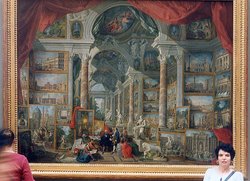Louvre
|
|
Louvreatnight.jpg
Louveinside.jpg
Ivue.jpg
The Louvre Museum (Musée du Louvre) in Paris, France, is one of the largest and most famous museums in the world. The building, a former royal palace, lies in the centre of Paris, between the Seine river and the Rue de Rivoli. Its central courtyard, now occupied by the Louvre glass pyramid, lies in the axis of the Champs-Élysées, and thus forms the nucleus from which the Axe historique springs. Part of the royal Palace of the Louvre was first opened to the public as a museum on November 8, 1793, during the French Revolution.
| Contents |
The building
The first royal "Castle of the Louvre" on this site was founded by Philippe II in 1190, as a fortress to defend Paris on its west against Viking attacks. In the 14th century, Charles V turned it into a palace, but Francois I and Henri II tore it down to build a real palace; the foundations of the original fortress tower are now under the Salle des Cariatides (Room of the Caryatids).
The existing part of the Chateau du Louvre was begun in 1546. The architect Pierre Lescot introduced to Paris the new design vocabulary of the Renaissance, which had been developed in the chateaux of the Loire. His new wing for the old castle defined its status, as the first among the royal palaces. J. A. du Cerceau also worked on the Louvre.
During his reign (1589 - 1610), King Henri IV added the Grande Galerie. More than a quarter of a mile long and one hundred feet wide, this huge addition was built along the bank of the Seine River and at the time was the longest edifice of its kind in the world. Henri IV, a promoter of the arts, invited hundreds of artists and craftsmen to live and work on the building's lower floors. This tradition continued for another two hundred years until Napoleon ended it.
Architect Claude Perrault's eastern wing (1665 - 1680), crowned by an uncompromising Italian balustrade along its distinctly non-French flat roof, was a ground-breaking departure in French architecture. His severe design was chosen over a design provided by the great Bernini, who came to Paris for the purpose. Perrault had translated the Roman architect Vitruvius into French. Now Perrault's rhythmical paired columns form a shadowed colonnade with a central pedimented triumphal arch entrance raised on a high, rather defensive basement, in a restrained classicizing baroque manner that has provided models for grand edifices in Europe and America for centuries. The Metropolitan Museum in New York, for one example, reflects Perrault's Louvre design.
The Louvre was still being added to by Napoleon III. The new wing of 1852 - 1857, by architects Visconti and Hector Lefuel, represents the Second Empire's version of Neo-Baroque, restlessly charged with detail everywhere and laden with sculpture. Work continued until 1876.
The museum


The Louvre holds the rich artistic heritage of the French people from the early Capetian Kings through the Empire of Napoleon Bonaparte and to the present day.
Long managed by the French state under the Réunion des Musées Nationaux the Louvre has recently acquired powers of self-management as an "Etablissement Public Autonome" in order to better manage its growth.
Among the thousands of priceless paintings is the Mona Lisa, perhaps the most famous painting in the world. Works of artists like Fragonard, Rembrandt, Rubens, Titian, Poussin, David, and Leonardo da Vinci can also be seen. Among the well-known sculptures in the collection are the Winged Victory of Samothrace and the Venus de Milo.
The collection of Baron Edmond de Rothschild (1845-1934), given to the Louvre in 1935, fills an exhibition room. It contains more than 40,000 engravings, nearly 3,000 drawings and 500 illustrated books.
Besides art, the Louvre has many other types of exhibits, including archeology, history, and architecture. It has a large furniture collection, whose most spectacular item used to be the Bureau du Roi of the 18th century, now returned to the Palace of Versailles.
The most recent significant modification of the Louvre was the "Grand Louvre" project, under president François Mitterrand. This opened the north wing of the building, which had hitherto housed government offices, and covered over several small internal courtyards. Most spectacular of all, it added a glass pyramid designed by the architect I. M. Pei at the center of the palace. The much expanded and re-organized Louvre reopened in 1989.
Access
Metro Palais-Royal-Musée-du-Louvre or Louvre-Rivoli.
Notable works
Famous artworks in the Louvre include:
- Et in Arcadia ego
- Lady of Auxerre
- Mona Lisa
- Nike of Samothrace (illustrated)
- Ship of Fools
- Venus de Milo
- The Virgin and Child with St. Anne
External links
- Musée du Louvre - Louvre Museum (http://www.insecula.com/musee/M0001.html/) – More than 10.000 pictures
- Louvre Home Page (French) (http://www.louvre.fr)
- Louvre Home Page (English) (http://www.louvre.fr/louvrea.htm)
- History of the Louvre (http://www.discoverfrance.net/France/Paris/Museums-Paris/Louvre.shtml)de:Louvre
es:Museo del Louvre fr:Musée du Louvre ko:루브르 박물관 it:Musée du Louvre di Parigi he:מוזיאון הלובר nl:Louvre no:Louvre ja:ルーヴル美術館 pl:Luwr pt:Museu do Louvre ro:Muzeul Luvru ru:Лувр sv:Louvren zh:卢浮宫
